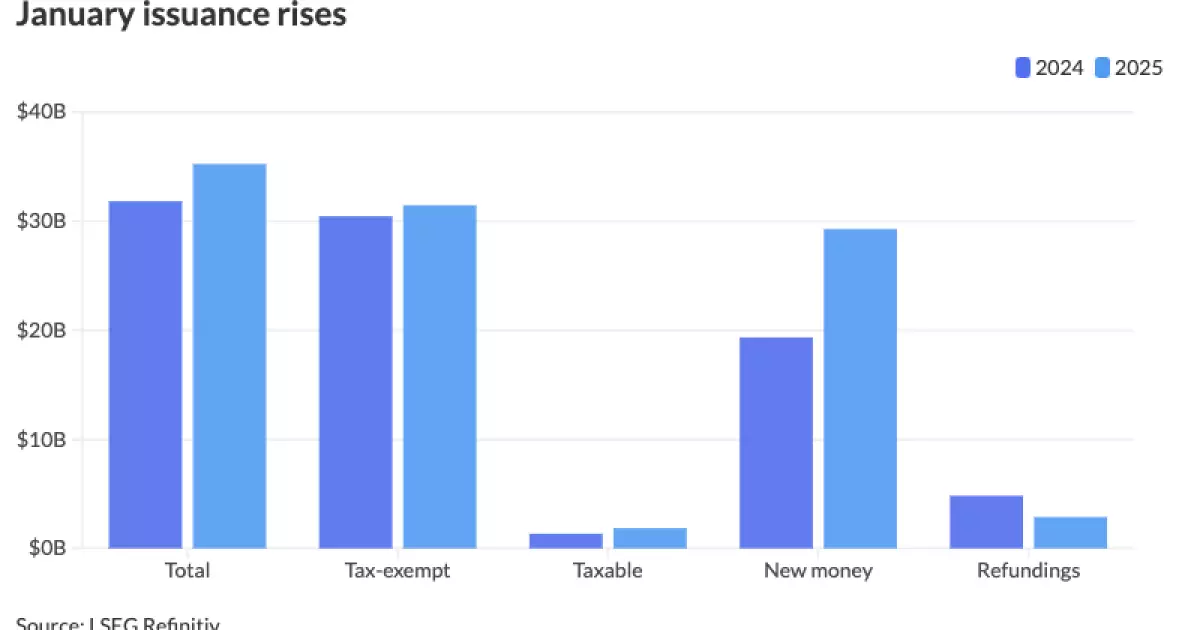In the world of municipal finance, January 2025 has proven to be an unexpectedly robust month for bond issuance. As municipal issuers rushed to market, the total volume rose to a striking $35.243 billion across 486 separate issues, an impressive 10.8% increase compared to the same month last year. This article examines the factors driving this surge, the implications for the broader market, and potential future trends as we progress into 2025.
One critical factor contributing to the heightened issuance volume is the backdrop of policy uncertainty, particularly related to federal fiscal and monetary policies. Credit analyst Alice Cheng from Janney reported that this uncertainty, driven partly by the Federal Reserve’s meetings and external pressures, has compelled many issuers to act proactively. The fear of prospective changes to the tax code tied to infrastructure spending has added additional urgency to the matter, as issuers aim to secure financing before future conditions become less favorable.
Cheng noted how the wait-and-see approach commonly adopted in uncertain times has given way to action, which directly correlates with the significant capital needs driven by dwindling COVID-era aid. As municipalities face mounting operational costs and initiatives requiring funding, the proactive stance taken in January reflects a shift in strategy aimed at mitigating volatility.
Tax implications are another crucial element influencing the current surge in bond issuance. James Pruskowski from 16Rock Asset Management pointed out that concerns over potential changes to tax exemption statuses could be prompting municipalities to issue debts earlier in the year. This strategic positioning allows them to capitalize on favorable conditions while also safeguarding against potential legislative changes that would impact their future financing options.
In the context of tax-exempt and taxable bond issuance, January witnessed a 3.3% increase in tax-exempt bonds, totaling $31.45 billion. Meanwhile, taxable bonds surged even more significantly, marking a 36.7% rise, evidencing the changing preferences among investors and issuers alike.
The recent surge in issuance can also be attributed to pent-up demand stemming from missed opportunities in 2024. Market observers noted that significant volatility, particularly towards the end of last year post-election, sidelined many issuers. Rob Dailey, head of PNC Public Finance, emphasized that projects previously stalled are now seeing renewed momentum as funds from federal infrastructure initiatives catalyze further local investment.
The increase in new-money issuance – up 51.4% to $29.268 billion – is indicative of municipalities ramping up projects that had been delayed or paused. This reflects not only a recovery but an aggressive approach to capitalize on available funding opportunities before market conditions change again.
Market participants are optimistic about the trajectory for municipal bonds throughout 2025, with projections suggesting a sustained robust pipeline fueled by both necessity and opportunity. Barclays strategist Mikhail Foux predicted that January’s strong supply signal indicates a year ahead marked by continued activity in the bond market.
This optimism is underscored by the observed increase in revenue bonds and general obligation bonds, rising 14% and 4.4%, respectively, from the previous year. Such indicators suggest not only a recovery but also considerable proactive efforts made by issuers to align funding with critical project timelines.
Diving deeper into regional issuance figures, California retained the top spot with $6.371 billion in bond issuance, a considerable month-on-month increase of 12.6%. This was followed closely by Texas and Florida, which saw their issuance volumes grow significantly as well. Each state’s response to the current economic landscape illustrates regional differences in strategies and priorities, offering insights into localized financial conditions.
The issue of regional disparities emphasizes how local economic conditions and specific projects influence market movements. For instance, states that effectively coordinated their bond issuances and aligned with federal aid appear better positioned to manage their growth amid the prevailing climate.
The surge in municipal bond issuance this January signals a potent mix of proactive strategies amid uncertainty and emerging needs for capital. As municipalities confront operational challenges and strive for growth by leveraging federal support, the landscape of bond issuance looks set for a transformative year. While external variables such as federal policies and tax regulations may influence the market, the fundamental drive for financing critical projects will likely dominate the discourse in the coming months, shaping the future of municipal financing in 2025 and beyond.


Leave a Reply